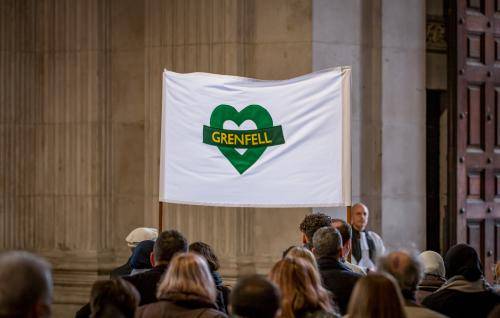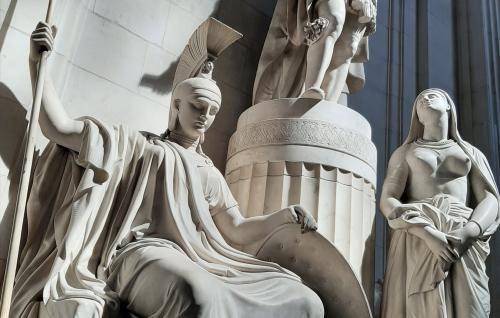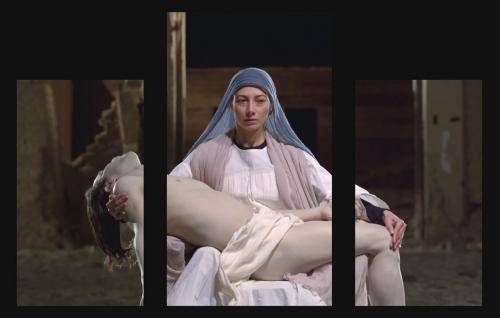Nelson, Wellington and Churchill
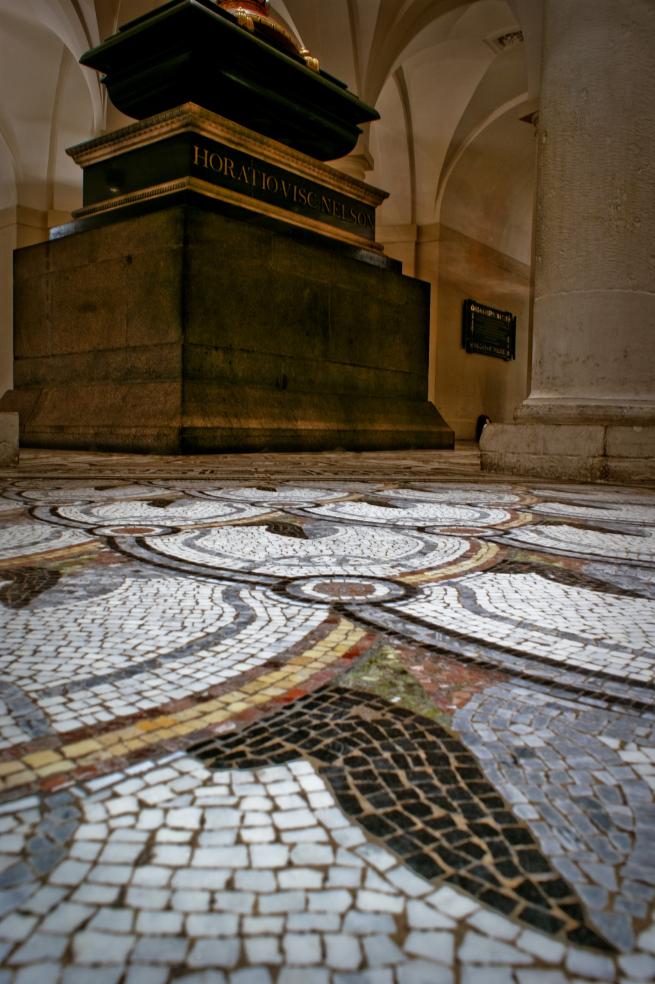
Photo of Nelson's tomb with mosaics in the Crypt by Graham Lacdao.
Nelson, Wellington and Churchill
The three state funerals hosted at St Paul’s were some of the biggest events in our history. They were spectacular in their pomp and ceremony, held to honour people considered to be of national importance.
Horatio Nelson (1758-1805)
The first was for Horatio Nelson, an Admiral whose military brilliance combined with human fallibility made him extraordinarily popular in his own lifetime.
His career coincided with a peak in British naval success – and it was Nelson’s leadership, grasp of strategy, and unconventional tactics which helped to achieve it. His death at the battle of Trafalgar, which foiled plans for an invasion of England, cemented his status as a national hero. Over time, his behaviour has been assessed more critically, particularly his views in relation to the slave trade.
Nelson was killed by a gunshot on the 21st October 1805. Dying at sea, his body was preserved in a barrel of rum for the journey back to England. He lay in state in The Painted Hall at Greenwich from the 5th – 7th January, before being placed in Charles II's state barge and rowed to Westminster. The following day he travelled through the streets to St Paul’s in a funeral carriage modelled on his ship The Victory.
Nelson did not expect to be buried in St Paul’s – he famously shouted “Westminster Abbey or glorious victory!” at the battle of Cape St Vincent in 1797. However, by the time he died, the Abbey was full. He was buried in the Cathedral Crypt following his funeral service on the 9th January 1806. The Prince of Wales and the Admiral of the Fleet, Sir Peter Parker, were the top ranking attendees, and the service was also attended by a young man who would go on to be Dean of St Paul’s – Henry Hart Milman. He recalled: “the solemn effect of the sinking of the coffin and heard, or imagined he heard, the low wail of the sailors who bore and encircled the remains of the admiral”.
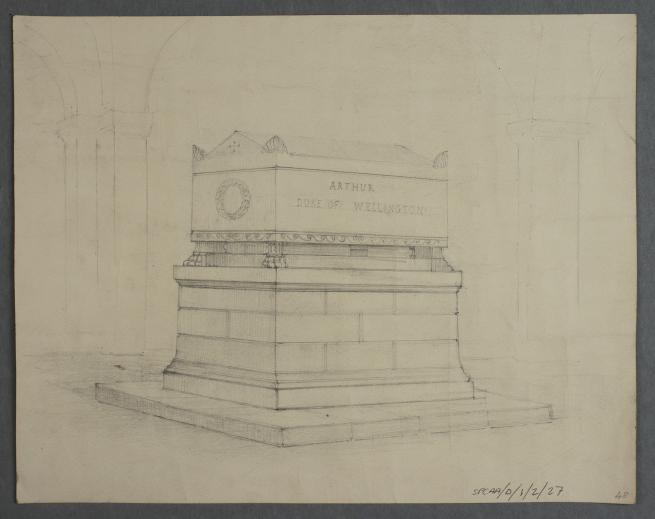
Sketch perspective showing an early or alternative design for the Wellington tomb (unrealised), by F. C. Penrose, 1850s (Ref. No. SPCAA/D/1/2/27)
Wellington (1769-1852)
Arthur Wellesley the 1st Duke of Wellington was, like Nelson, a hero of the wars with Napoleonic France. He fought in conflicts across the British Empire, but it was his victory at the Battle of Waterloo in 1815, bringing a decisive end to twelve years of conflict, which ensured his place in history. After the wars, his popularity would dip owing to his resistance to political reform but he was still afforded a state funeral when he died.
After lying in-state at Chelsea Hospital, Wellington’s coffin was processed to St Paul’s on a funeral carriage. An estimated 1.5m people converged on the procession route on 18 November 1852. The carriage was cast from over 10 tons of bronze cannons captured at Waterloo – six foundries employed over 100 men for 18 days to make it. When it reached St Paul’s Cathedral, however, its mechanism failed: it took over an hour for the Duke’s coffin to be conveyed inside.
Up to 15,000 people gathered inside the Cathedral for the funeral. Prince Albert and other members of the Royal Family, the two Houses of Parliament, Officials from the City of London and Livery Companies and ambassadors from overseas, all attended. They were seated in hastily erected tiered seating made especially for the event.
The interior of the Cathedral was blacked out and the funeral service was the simple burial service of the Church of England. The Illustrated London News commemorated the event the next day, printing: “Wellington and Nelson sleep side by side under the Dome of St. Paul's, and the national mausoleum of our isles has received the most illustrious of its dead.”
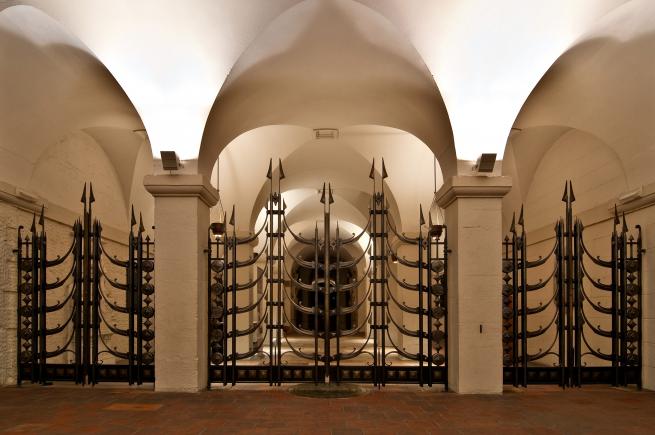
Photo of the Churchill gates in the Crypt by Graham Lacdao.
Winston Churchill (1874-1965)
‘Operation Hope Not’ was the code name given to the state funeral of Winston Churchill. As the Prime Minister of the United Kingdom during the Second World War, he led the country through incredibly challenging times, fending off the threat of invasion and enabling a fight back against the Nazi occupation of Europe, in alliance with America and the Soviet Union. He is also a figure of controversy, especially when viewed from a modern perspective.
His body was left to lie in state in Westminster, after which an extraordinary procession carried him to St Paul’s. After the ceremony, his procession continued – via the river Thames by boat, where there were gun salutes, construction cranes lining the route, and a military fly-past, to Waterloo, where his body was carried by train to its burial place at Bladon, Oxfordshire.
Attendees at the ceremony came from around the globe with Commonwealth and other world leaders assembled: President Kaunda from Zambia, President Shazar of Israel, the German Chancellor and foreign minister, the Indian and Pakistani foreign ministers and the Crown Prince of Ethiopia all took their places beneath the Dome. The memorial and Thanksgiving ceremonies held throughout the war years had hosted foreign troops and dignitaries but Churchill’s funeral was one of the most international occasions St Paul’s had ever seen.
The British Royal family were nearly the last to arrive – and the monarch’s presence at a state funeral was unprecedented. The Queen and her family were led in procession to their seats by the Archbishop of Canterbury, the Bishop of London and the Cathedral Chapter. The Chapter wore black copes made especially for the occasion, trimmed with silver silk braid, the hoods emblazoned with the crossed swords of St Paul in silver embroidery. These, together with the funeral pall, remain in the Cathedral Collections today.





